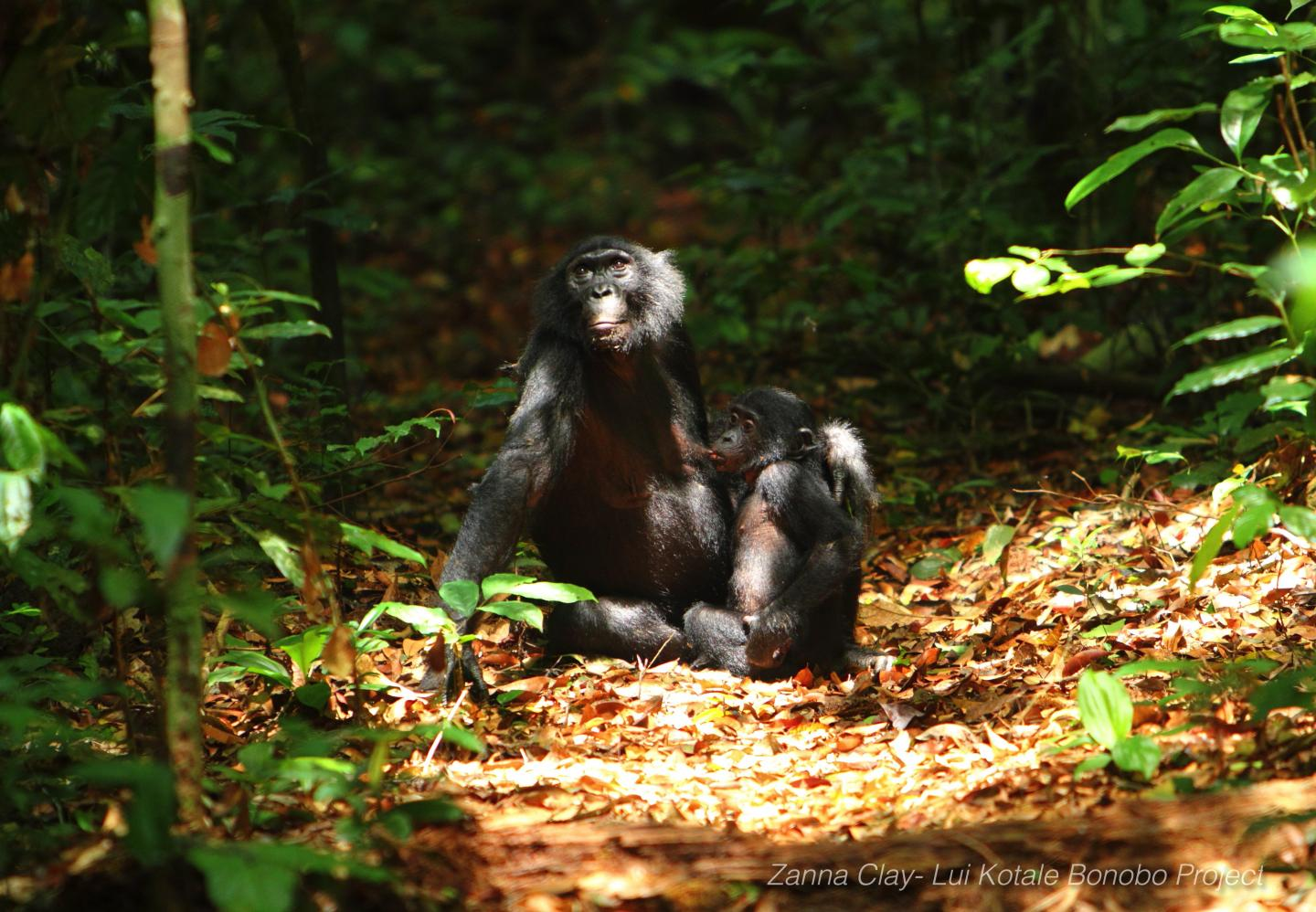Bonobo communication is an intriguing area of study that reveals parallels with human linguistic behavior, particularly in vocalizations. Researchers find that these intelligent primates utilize a system of complex calls and signals, akin to word compounds in human language, to convey intricate social dynamics. Mia, a young female bonobo, exemplifies this when she vocalizes to distant members of her group, demonstrating the significance of sound in coordinating social interactions. With evidence suggesting that bonobo vocalizations feature elements of compositionality, we gain insight into the evolution of language and the roots of animal communication. Understanding such sophisticated social behavior not only deepens our knowledge of bonobos but also sheds light on how language may have evolved within our own species.
Exploring the nuances of bonobo vocalizations offers a fascinating glimpse into the realm of primate language and social interaction. This form of animal communication transcends simple sounds; instead, it operates on a level of complexity similar to that of human language systems. The study of informed gestures and vocal expressions highlights how this ape’s intricate social behavior can influence their vocal patterns, thereby enhancing the bonds within their communities. Moreover, by analyzing the compositional aspects of these calls, researchers can unravel the cognitive processes behind their interactions, providing a pivotal link in understanding the evolution of communication. As we conceptualize bonobo social structures and their linguistic abilities, we further reveal the interconnectedness of all living beings.
Understanding Bonobo Vocalizations: A Window into Animal Communication
Bonobos possess a rich and complex vocalization system that plays a significant role in their social interactions. These vocalizations, ranging from whistles to peeps, help them coordinate activities and navigate the intricate dynamics of their social groups. When a bonobo emits specific sounds, it can indicate various social scenarios like tension or the need for proximity to group members. This suggests that their communication goes beyond simple sounds and enters the realm of nuanced social cues, much like human language. Understanding how these vocalizations function can deepen our insight into the evolution of communication.
The research highlights that bonobos use a compositional language system, which allows them to create new meanings from combinations of sounds. For instance, vocalizations that signify urgency can vary based on the context or the social situation, indicating a clear understanding of social nuances and relationships. This complexity in their vocalization points to an advanced form of animal communication that may bear similarities to the early stages of human language, showcasing not just how bonobos communicate, but also how this might reflect the evolutionary path of social interaction.
The Role of Compositionality in Bonobo Communication
Compositionality refers to the ability to combine smaller units of meaning to create larger expressions, a feature that is often associated with human language. Recent studies on bonobo vocalizations have revealed that these apes exhibit similar characteristics, creating a form of communication that resembles the way humans string together words to convey complex ideas. For example, a simple peep might transform into a call that signifies an imminent action or a warning when coupled with other sounds, demonstrating their understanding of context in social settings. This capacity to produce compound vocalizations represents a significant step toward understanding the evolutionary aspects of language.
The presence of compositionality in bonobo communication offers insight into the foundational elements of language evolution. It suggests that the ability to manipulate sounds for social interaction has roots that stem far back in our shared ancestry with bonobos. By studying the various vocal combinations used by bonobos, researchers can glean information about how social structures influence communication systems across species. This not only illuminates aspects of bonobo social behavior but also invites comparisons with early human communication, opening new avenues for research on the origins of language.
Bonobo Social Behavior and Communication Dynamics
Bonobos are known for their complex social structures, which significantly impact their communication practices. These primates often form intricate social bonds that facilitate cooperation and alliance-building, crucial for their survival in the wild. As observed in the Kokolopori reserve, the ability to vocalize effectively allows bonobos to maintain these connections, especially when groups split and reunite. Their vocal behaviors, including specific calls and signals, help navigate these situations, reinforcing social ties and enabling coordinated movements among members.
The dynamics of bonobo social behavior provide a fascinating backdrop for their communication strategies. By employing various vocalizations to signal different social contexts, they demonstrate an impressive awareness of their relationships and environments. This reflects a sophisticated understanding of their social landscapes, with vocal cues acting as critical tools for cooperation and relationship management within their groups. Such insights into bonobo social behavior can enhance our understanding of animal communication systems and their evolutionary implications.
The Implications of Bonobo Language Studies for Human Evolution
The exploration of bonobo communication has substantial implications for understanding human evolution. Researchers suggest that the features observed in bonobo vocalizations could illuminate aspects of early human language development. Since bonobos and humans share a common ancestor, studying how these apes utilize vocalizations helps us trace the roots of compositionality and complex social communication. By recognizing these traits in bonobos, we gain a clearer picture of how language might have evolved, showcasing our shared lineage and the gradual development of communication systems.
Furthermore, understanding the language capabilities of bonobos can reshape our perceptions of what it means to communicate. The parallels drawn between bonobo and human communication challenge the notion that language is an exclusively human trait. It opens up new discussions about cognitive abilities in animals, suggesting that the building blocks of language predate the human species. This perspective fosters a greater appreciation of animal communication and its evolutionary significance, emphasizing that advanced forms of interaction may be present in species alongside humans.
Vocal Complexity and Social Intelligence in Bonobos
Vocal complexity in bonobos is closely tied to their social intelligence, as evidenced by their ability to navigate complex group dynamics. Bonobos have been seen using an array of calls to signify different social situations, showcasing their advanced cognitive skills. These vocalizations not only serve functional purposes, such as coordinating movements or alerting group members to dangers, but also play a pivotal role in maintaining their intricate social relationships. This level of vocal sophistication indicates that bonobos possess a form of social intelligence that allows them to adapt their communication according to the context.
The relationship between vocal complexity and social structures is a vital area of research in understanding both bonobo and human communication. The varied vocal expressions of bonobos reflect their ability to form deep interpersonal connections within their groups, much like human interactions. As these vocalizations convey nuanced meanings based on context and relationships, they underscore the importance of flexible communication in fostering social cohesion and cooperation among individuals. This connection between vocal complexity and social intelligence provides important insights into the evolutionary pressures that shaped communication.
Research Methods in Bonobo Vocalization Studies
Researching bonobo vocalizations involves innovative methods that bridge the gap between animal behavior studies and human linguistics. Scientists have employed rigorous observational techniques to document the contextual factors surrounding each vocalization, thereby creating a detailed catalog of bonobo sounds and their meanings. The systematic collection of this data allows researchers to identify patterns and derive correlations between specific calls and social behaviors. This approach not only enriches our understanding of bonobo communication but also enhances methodologies across animal communication research.
The collaborative efforts among researchers from different institutions highlight the importance of interdisciplinary methods in studying animal behavior. By adapting linguistic frameworks to analyze bonobo vocalizations, researchers can apply concepts like compositionality to animal communication. This has laid the groundwork for more structured studies on other species, expanding the field of animal communication research. The implications of these methods are vast, potentially informing not just the nature of bonobo communication but also our broader understanding of the evolutionary processes that shape communication across various species.
The Significance of Bonobo Communication in Conservation Efforts
Understanding bonobo communication is pivotal not only for academic purposes but also for conservation efforts. As bonobos face habitat loss and poaching, insights gained from their vocal behaviors can inform strategies aimed at preserving their natural habitats. By recognizing how vocal communication influences social structures, conservationists can develop more effective interventions that support the social cohesion crucial for bonobo populations. Protecting their communication habitats ensures that these vocalizations continue to thrive, contributing to the species’ survival.
Furthermore, emphasizing understanding bonobo communication in conservation dialogue raises awareness about the complexities of these primates. Showcasing their sophisticated social behaviors and communication strategies can help shift public perception, fostering empathy and support for conservation initiatives. As people learn more about the advanced communication systems of bonobos, it highlights the urgency of preserving their natural environments and maintaining biodiversity. This connection between communication and conservation underscores the integral relationship between species survival and effective communication practices.
Future Directions in Bonobo Communication Research
The study of bonobo communication is rapidly evolving, propelled by advances in technology and research methodologies. Future research directions may explore deeper into the nuances of bonobo vocalizations, investigating the psychological and emotional underpinnings of their communication. Using acoustic analysis tools, researchers can examine the frequency and pitch variations of calls to gain insights into emotional states and decision-making processes. These investigations promise to unravel even more complexities in bonobo social interactions and communication.
Additionally, longitudinal studies tracking changes in vocalization patterns over time can enhance understanding of how bonobo communication adapts to evolving social contexts. As environmental pressures shift, observing how bonobos modify their communication could elucidate the adaptive nature of language. Regardless of the specific focus, ongoing research will continue to bridge the gap between animal vocalizations and human language evolution, providing invaluable knowledge about our shared ancestry and the sophistication of non-human communication.
Frequently Asked Questions
What are bonobo vocalizations and how do they relate to animal communication?
Bonobo vocalizations consist of various sounds, including peeps, yelps, and whistles, used to convey complex social messages. These vocalizations play a crucial role in bonobo communication, allowing them to coordinate movements and express emotions. Research has shown that these calls display compositionality, similar to human language, suggesting that bonobos may communicate intricate ideas and social situations effectively, highlighting their sophisticated social behavior.
How do bonobo vocalizations demonstrate compositionality in communication?
Compositionality in bonobo vocalizations refers to their ability to combine different sounds to create meaningful sequences. For instance, a whistle can indicate coordination with distant group members, while preceding sounds can signify social tension. This complexity mirrors human language, where words combine to provide nuanced meanings, indicating that the evolution of animal communication may have roots in similar mechanisms of language development.
What role does social behavior play in bonobo communication?
Bonobo social behavior is deeply intertwined with their communication methods. They form complex social bonds and utilize vocalizations to maintain relationships, particularly when social groups split and reunite. Their communication system, characterized by both individual calls and sequences of sounds, enables them to navigate social structures effectively, reflecting the sophisticated nature of bonobo society and signaling the importance of vocal interactions.
Can bonobos convey emotions through vocalizations?
Yes, bonobos can convey emotions through their vocalizations. Each sound, whether a peep or a whistle, can signify different emotional states or social contexts. For example, a subtle peep may indicate anxiety or tension, while other sounds communicate excitement or alertness to potential threats. This emotional depth in their communication underscores the complexity of bonobo social behavior and their ability to express intricate emotional landscapes.
How might bonobo communication inform our understanding of language evolution?
The study of bonobo communication provides valuable insights into language evolution as it reveals that the capacity for complex vocalizations and compositionality may predate human language. By comparing bonobo vocal behavior to human linguistic constructs, researchers can better understand the evolutionary roots of communication and how social structures influence vocal complexity. This suggests that the development of language may share commonalities with animal communication systems.
What are the implications of bonobo vocal communication for understanding animal intelligence?
Bonobo vocal communication has significant implications for understanding animal intelligence. The ability to use compositionality and convey complex social messages indicates a level of cognitive sophistication previously underestimated in non-human species. This complexity in communication suggests that bonobos possess advanced social intelligence, enriching our perspective on animal cognition and the evolutionary paths of communication among species.
| Key Point | Details |
|---|---|
| Bonobo Vocalizations | Bonobos vocalize similarly to humans, employing a dictionary of vocalizations showing they can communicate complex social situations. |
| Compositionality in Communication | Bonobos utilize word compounds and phrases in their vocal communication, suggesting the roots of language may predate humans. |
| Research Overview | The study involved eight months of data collection in the Kokolopori reserve, focusing on contextual features of vocalization. |
| Social Complexity | Bonobos develop complex social bonds, and their vocal communication helps coordinate group movements and manage social interactions. |
| Evolutionary Significance | Findings indicate that complex communication systems in bonobos and chimpanzees evolved to maintain social relationships across distances. |
Summary
Bonobo communication reveals remarkable parallels to human language, demonstrating complex vocal interactions and social nuances. This insight into bonobo communication not only enriches our understanding of these primates but also sheds light on the evolutionary roots of language itself. Researchers are now aware that the building blocks of communication may have existed long before modern humans, highlighting the intricate and dynamic nature of interactions within bonobo social structures.



